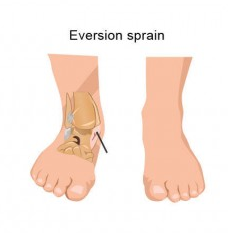Ankle Talk: Rehabbing an Eversion Ankle Sprain
An eversion ankle sprain can happen when your ankle rolls too far outward. It causes swelling, bruising and pain on the inside of the ankle. In severe cases, you can tear a ligament, which usually requires surgery. (See How Severe Is Your Sprained Ankle?)
If you suspect you’ve suffered an eversion sprain, apply ice and pressure and elevate the ankle for 15 to 20 minutes to help reduce swelling. Wrapping your ankle will stabilize it and help prevent further injury. You should also consult a doctor to make sure nothing is broken. With your doctor’s OK, take ibuprofen to cut down on the pain.
All eversion sprains require rehab, but it can take two weeks for the swelling to subside and rehab to begin. (See Treating an Ankle Sprain.)
Once the swelling goes down, you can begin to perform towel exercises. Place a towel around your foot, from just below the big toe to the pinky toe, and grab both ends—one in each hand. Push through your toes while providing some resistance with the towel.
If this causes pain—STOP! You can do the same exercise without any resistance by simply flexing your foot to increase your range of motion.
You can also use a resistance band—adding progressive resistance as the ankle heals—to begin strengthening the weakened joint. Practice rotating your foot from side to side (eversion and inversion) with the resistance band, then up toward your leg (dorsiflexion), then pointing down (plantar flexion). (See also Rehabbing a Low Ankle Sprain.)
Depending on the severity of the eversion sprain, it could take four to six weeks for your ankle to totally heal. Once you are pain-free, you can return to normal activity. (See Avoid Injuries With Dwyane Wade’s Ankle Strength Routine.)
Be patient and cautious. It’s easy to underestimate this injury. Some sprains are actually worse than breaks.
Photo: sinewtherapeutics.com
RECOMMENDED FOR YOU
MOST POPULAR
Ankle Talk: Rehabbing an Eversion Ankle Sprain
An eversion ankle sprain can happen when your ankle rolls too far outward. It causes swelling, bruising and pain on the inside of the ankle. In severe cases, you can tear a ligament, which usually requires surgery. (See How Severe Is Your Sprained Ankle?)
If you suspect you’ve suffered an eversion sprain, apply ice and pressure and elevate the ankle for 15 to 20 minutes to help reduce swelling. Wrapping your ankle will stabilize it and help prevent further injury. You should also consult a doctor to make sure nothing is broken. With your doctor’s OK, take ibuprofen to cut down on the pain.
All eversion sprains require rehab, but it can take two weeks for the swelling to subside and rehab to begin. (See Treating an Ankle Sprain.)
Once the swelling goes down, you can begin to perform towel exercises. Place a towel around your foot, from just below the big toe to the pinky toe, and grab both ends—one in each hand. Push through your toes while providing some resistance with the towel.
If this causes pain—STOP! You can do the same exercise without any resistance by simply flexing your foot to increase your range of motion.
You can also use a resistance band—adding progressive resistance as the ankle heals—to begin strengthening the weakened joint. Practice rotating your foot from side to side (eversion and inversion) with the resistance band, then up toward your leg (dorsiflexion), then pointing down (plantar flexion). (See also Rehabbing a Low Ankle Sprain.)
Depending on the severity of the eversion sprain, it could take four to six weeks for your ankle to totally heal. Once you are pain-free, you can return to normal activity. (See Avoid Injuries With Dwyane Wade’s Ankle Strength Routine.)
Be patient and cautious. It’s easy to underestimate this injury. Some sprains are actually worse than breaks.
Photo: sinewtherapeutics.com












